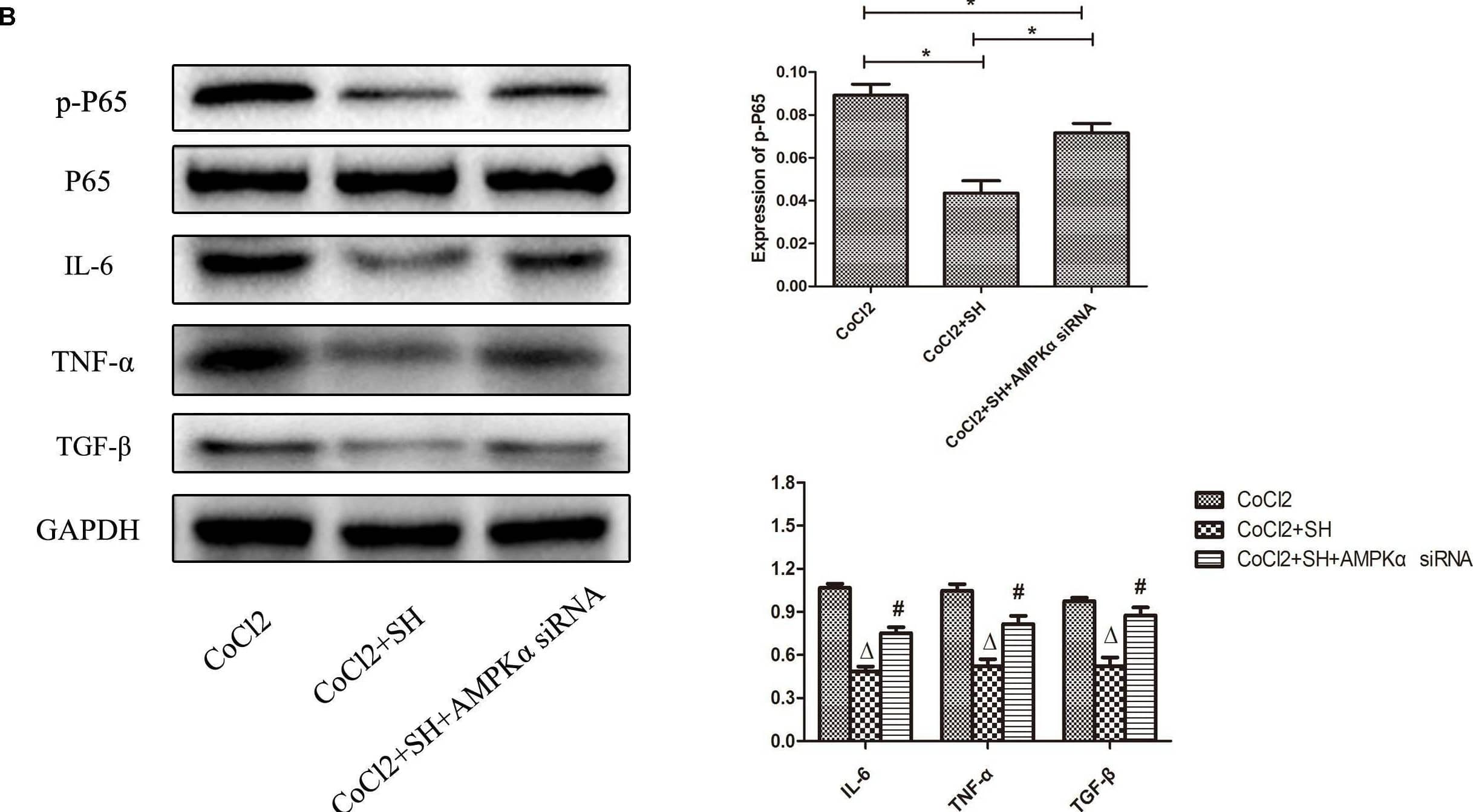Rat IL-6 Antibody Summary
Phe25-Thr211
Accession # P20607.1
Applications
Please Note: Optimal dilutions should be determined by each laboratory for each application. General Protocols are available in the Technical Information section on our website.
Scientific Data
 View Larger
View Larger
Detection of IL-6 by Western Blot Transfection H9C2 with AMPK alpha siRNA reversed the suppression of NF-kB p65 and pro-inflammatory cytokines by SH post-hypoxia. (A) The expression of AMPK of H9C2 transfected with AMPK alpha siRNA. Control, n = 6; non-target siRNA, n = 6; AMPK alpha siRNA, n = 6. NS indicated p > 0.05, ∗indicated p < 0.05. (B) The expression of NF-kB p65, IL-6 and TNF alpha of H9C2 transfected with AMPK alpha siRNA. CoCl2, n = 6; CoCl2+SH, n = 6; CoCl2+SH+AMPK alpha siRNA, n = 6. ∗Indicated p < 0.05; delta compared with CoCl2 group, p < 0.05; #compared with CoCl2+SH group, p < 0.05. Image collected and cropped by CiteAb from the following open publication (https://pubmed.ncbi.nlm.nih.gov/30319423), licensed under a CC-BY license. Not internally tested by R&D Systems.
Reconstitution Calculator
Preparation and Storage
- 12 months from date of receipt, -20 to -70 °C as supplied.
- 1 month, 2 to 8 °C under sterile conditions after reconstitution.
- 6 months, -20 to -70 °C under sterile conditions after reconstitution.
Background: IL-6
Interleukin-6 (IL-6) is a pleiotropic, alpha -helical, phosphorylated and variably glycosylated cytokine that plays important roles in the acute phase reaction, inflammation, hematopoiesis, bone metabolism, and cancer progression. Mature rat IL-6 is 187 amino acids (aa) in length that is typically expressed as a 22-28 kDA molecular weight protein. Rat IL-6 shares 39% and 85% aa sequence identity with human and mouse IL-6, respectively. Alternative splicing generates several isoforms with internal deletions, some of which exhibit antagonistic properties. IL-6 induces signaling through a cell surface heterodimeric receptor complex composed of a ligand binding subunit (IL-6 R alpha) and a signal transducing subunit (gp130). IL-6 binds to IL-6 R alpha, triggering IL-6 R alpha association with gp130 and gp130 dimerization. gp130 is also a component of the receptors for CLC, CNTF, CT-1, IL-11, IL-27, LIF, and OSM. Soluble forms of IL-6 R alpha are generated by both alternative splicing and proteolytic cleavage. In a mechanism known as trans-signaling, complexes of soluble IL-6 and IL-6 R alpha elicit responses from gp130-expressing cells that lack cell surface IL-6 R alpha. Trans-signaling enables a wider range of cell types to respond to IL-6, as the expression of gp130 is ubiquitous, while that of IL-6 R alpha is predominantly restricted to hepatocytes, monocytes, and resting lymphocytes. Soluble splice forms of gp130 block trans-signaling from IL-6/IL-6 R alpha but not from other cytokines that use gp130 as a co-receptor. IL-6, along with TNF-alpha and IL-1, function to drive the acute inflammatory response and the transition from acute inflammation to either acquired immunity or chronic inflammatory disease. When dysregulated, it contributes to chronic inflammation in obesity, insulin resistance, inflammatory bowel disease, arthritis, sepsis, and atherosclerosis. IL-6 can also function as an anti-inflammatory molecule, as in skeletal muscle where it is secreted in response to exercise. In addition, it enhances hematopoietic stem cell proliferation and the differentiation of Th17 cells, memory B cells, and plasma cells.
Product Datasheets
Citations for Rat IL-6 Antibody
R&D Systems personnel manually curate a database that contains references using R&D Systems products. The data collected includes not only links to publications in PubMed, but also provides information about sample types, species, and experimental conditions.
7
Citations: Showing 1 - 7
Filter your results:
Filter by:
-
TLR2/NF kappa B signalling regulates endogenous IL-6 release from marrow-derived mesenchymal stromal cells to suppress the apoptosis of PC12 cells injured by oxygen and glucose deprivation
Authors: XIA SHI, JINGJING LIU, TING YANG, YUN ZHANG, TINGYU LI, JIE CHEN
Molecular Medicine Reports
-
The P2X7 receptor links mechanical strain to cytokine IL-6 upregulation and release in neurons and astrocytes
Authors: W Lu, F Albalawi, JM Beckel, JC Lim, AM Laties, CH Mitchell
J. Neurochem, 2017-05-01;0(0):.
Species: Rat
Sample Types: Tissue Homogenates
Applications: Western Blot -
TLR2/NF kappa B signalling regulates endogenous IL-6 release from marrow-derived mesenchymal stromal cells to suppress the apoptosis of PC12 cells injured by oxygen and glucose deprivation
Authors: XIA SHI, JINGJING LIU, TING YANG, YUN ZHANG, TINGYU LI, JIE CHEN
Molecular Medicine Reports
Species: Rat
Sample Types: Cell Lysates
Applications: Western Blot -
Developmental regulation of the neuroinflammatory responses to LPS and/or hypoxia-ischemia between preterm and term neonates: An experimental study
Authors: Marie-Elsa Brochu, Sylvie Girard, Karine Lavoie, Guillaume Sébire
Journal of Neuroinflammation
Species: Rat
Sample Types: Whole Tissue
Applications: Immunohistochemistry -
Autoreactive T cells persist in rats protected against experimental autoimmune encephalomyelitis and can be activated through stimulation of innate immunity.
Authors: Conant SB, Swanborg RH
J. Immunol., 2004-05-01;172(9):5322-8.
Species: Rat
Sample Types: Whole Cells
Applications: Neutralization -
Developmental regulation of the neuroinflammatory responses to LPS and/or hypoxia-ischemia between preterm and term neonates: An experimental study
Authors: Marie-Elsa Brochu, Sylvie Girard, Karine Lavoie, Guillaume Sébire
Journal of Neuroinflammation
-
Gabexate mesilate ameliorates the neuropathic pain in a rat model by inhibition of proinflammatory cytokines and nitric oxide pathway via suppression of nuclear factor-kappa B
Authors: Seon Hee Oh, Hyun Young Lee, Young Joon Ki, Sang Hun Kim, Kyung Joon Lim, Ki Tae Jung
The Korean Journal of Pain
FAQs
No product specific FAQs exist for this product, however you may
View all Antibody FAQsReviews for Rat IL-6 Antibody
There are currently no reviews for this product. Be the first to review Rat IL-6 Antibody and earn rewards!
Have you used Rat IL-6 Antibody?
Submit a review and receive an Amazon gift card.
$25/€18/£15/$25CAN/¥75 Yuan/¥2500 Yen for a review with an image
$10/€7/£6/$10 CAD/¥70 Yuan/¥1110 Yen for a review without an image











